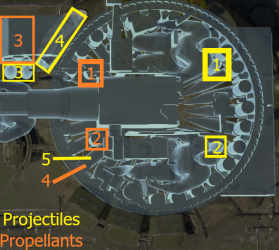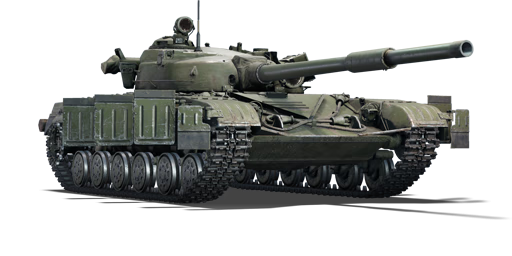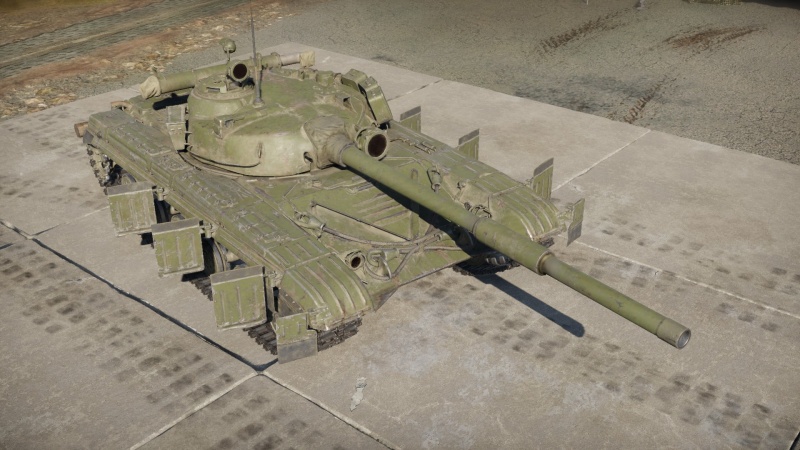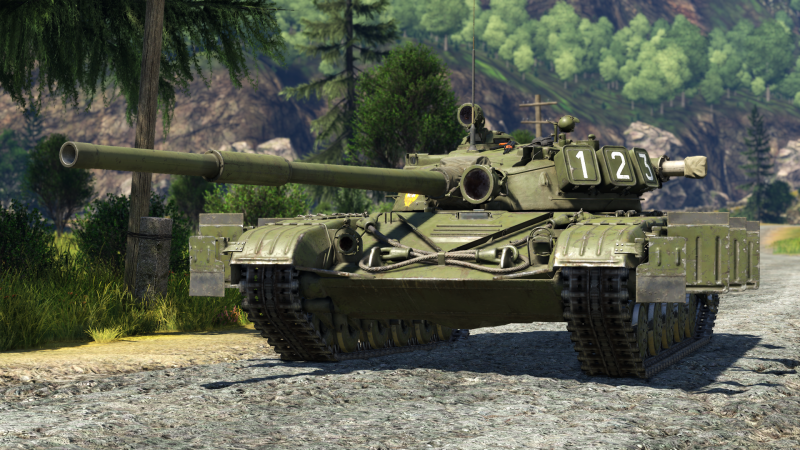T-64A (1971)
| This page is about the Soviet medium tank T-64A (1971). For other versions, see T-64 (Family). |
Contents
Description
The T-64A is the second variant of the T-64 main battle tank family. Even as the first variant of the T-64 was being produced, the design team was hard at work on a new variant, codenamed Object 434 (designated T-64A), to improve the firepower. The new variant was to be outfitted with a brand new and extremely powerful 125 mm D-81T tank gun from the Perm weapons factory. Given the increased calibre of the main armament, it is estimated that only a maximum of 25 rounds can be carried. This was unacceptable to the Soviet designers, but strict dimensional constraints prevented them from enlarging the design to increase interior space. The solution was to replace the human loader with a mechanical autoloader, reducing the crew to three and introducing autoloaders to Soviet main battle tanks for the first time.
Introduced in Update 1.71 "New E.R.A.", the T-64A should be played primarily defensively, using terrain for cover and pushing objectives with caution. It has good firepower but mediocre armour, average mobility, and a very slow reverse speed. Since many of the vehicles it will face will easily penetrate its hull armour, the T-64A should be played as a sniper, and close-range engagement should be avoided. Since the majority of the vehicles it will encounter have greater mobility, it is critical to be aware of enemies flanking around the battlefield.
General info
Survivability and armour
Armour type:
- Spaced armour (Hull front, Turret front)
- Cast homogeneous armour
- Rolled homogeneous armour (Turret)
| Armour | Front (Slope angle) | Sides | Rear | Roof |
|---|---|---|---|---|
| Hull | 80* mm (68°) Front glacis 80 mm (61°) Lower glacis |
85 mm Front 70 mm Rear <br. 20 mm (33°) Bottom |
20 mm (8-55°) Top 45 mm Center 20 mm (18-58°) Bottom |
30 mm Front 20 mm Engine deck |
| Turret | 50-330 mm (0-80°) | 65-180* mm (2-49°) | 65 mm (2-72°) | 40-140 mm |
| Cupola | 100 mm | 40 mm | ||
| Composite armour* | Front | Sides |
|---|---|---|
| Hull | 320 mm Kinetic 450 mm Chemical |
N/A |
| Turret | 400 mm Kinetic 450 mm Chemical |
400 mm Kinetic 450 mm Chemical |
Notes:
- Suspension wheels are 20 mm thick, torsion bars are 10 mm thick, and tracks are 30 mm thick.
- The side flaps on the hull side gives spaced protection against HEAT rounds, allowing one to angle the hull slightly while protecting the vulnerable side hull.
- Belly armour is 20 mm thick.
- A 5 mm RHA plate separates the engine from the crew compartment
- A log providing 100 mm thickness in wood.
- The snorkel tube on the turret rear provide 4 mm of structural steel.
- Hull roof armour at front and turret base is rated to be 30 mm effective against HE
- Hull spaced armour configuration is 80 mm RHA + 105 mm Textolite + 20 mm RHA.
- Turret spaced armour configuration is 150-180 mm CHA + 150 mm HHRA + 32 mm RHA.
The T-64A has composite armour over most of its upper front glacis and turret, although it has some obvious weak points - it has no LFP composite armour, the driver's port is not reinforced and there are some small sections of the turret that are easily penetrable. Unfortunately, though, many vehicles the T-64A will encounter have ammunition that can easily overmatch the UFP composite and often will simply punch straight through - it's best to avoid exposing the hull at all. HEAT ammunition is finicky as T-64A was built around protection specifications against shaped charges, the composite armour is 450 mm effective when against HEAT warheads and there are side flaps on the side hull to prevent even the chance of hitting the T-64A weaker side armour on the first try, although these side flaps are one-time use only so prolonged combat may have sheared these off already. Try to avoid aiming for the turret as it is the most protected area of the tank with a good portion covered by composite, leading to the need of massive amount of penetration to consider the turret a viable target, like the HOT missiles.
In a situation where the T-64A decides to hull-down and present as little of the front plate as possible, the best option is to attempt to disable the vehicle's gun - the mantlet is destroyed easily and combined with the sub-par reverse speed, this may provide enough time to push forward or around the vehicle and get a clear shot on the hull. Where possible, try to land the shot centre-mass below the turret which often causes an ammunition detonation.
Mobility
| Game Mode | Max Speed (km/h) | Weight (tons) | Engine power (horsepower) | Power-to-weight ratio (hp/ton) | |||
|---|---|---|---|---|---|---|---|
| Forward | Reverse | Stock | Upgraded | Stock | Upgraded | ||
| Arcade | 68 | 5 | 38 | 1,085 | 1,336 | 28.55 | 35.16 |
| Realistic | 61 | 5 | 619 | 700 | 16.29 | 18.42 | |
Modifications and economy
Armaments
Main armament
| 125 mm 2A26 | Turret rotation speed (°/s) | Reloading rate (seconds) | ||||||||
|---|---|---|---|---|---|---|---|---|---|---|
| Mode | Capacity | Vertical | Horizontal | Stabilizer | Stock | Upgraded | Full | Expert | Aced | Autoloader |
| Arcade | 37 | -6°/+14° | ±180° | Two-plane | 19.0 | 26.4 | 32.0 | 35.4 | 37.7 | 7.10 |
| Realistic | 11.9 | 14.0 | 17.0 | 18.8 | 20.0 | |||||
Ammunition
| Penetration statistics | |||||||
|---|---|---|---|---|---|---|---|
| Ammunition | Type of warhead |
Penetration @ 0° Angle of Attack (mm) | |||||
| 10 m | 100 m | 500 m | 1,000 m | 1,500 m | 2,000 m | ||
| 3BK12M | HEATFS | 440 | 440 | 440 | 440 | 440 | 440 |
| 3OF19 | HE | 35 | 35 | 35 | 35 | 35 | 35 |
| 3OF26 | HE | 42 | 42 | 42 | 42 | 42 | 42 |
| 3BM9 | APFSDS | 321 | 317 | 303 | 285 | 268 | 249 |
| 3BM15 | APFSDS | 440 | 430 | 420 | 410 | 405 | 400 |
| 3BM22 | APFSDS | 425 | 420 | 415 | 405 | 393 | 380 |
| Shell details | ||||||||||||
|---|---|---|---|---|---|---|---|---|---|---|---|---|
| Ammunition | Type of warhead |
Velocity (m/s) |
Projectile mass (kg) |
Fuse delay (m) |
Fuse sensitivity (mm) |
Explosive mass (TNT equivalent) (kg) |
Ricochet | |||||
| 0% | 50% | 100% | ||||||||||
| 3BK12M | HEATFS | 905 | 19 | 0.05 | 0.1 | 2.06 | 65° | 72° | 77° | |||
| 3OF19 | HE | 850 | 23.2 | 0.3 | 0.1 | 3.15 | 79° | 80° | 81° | |||
| 3OF26 | HE | 850 | 23 | 0.3 | 0.1 | 5.24 | 79° | 80° | 81° | |||
| 3BM9 | APFSDS | 1,800 | 3.6 | - | - | - | 72° | 76° | 78° | |||
| 3BM15 | APFSDS | 1,780 | 3.88 | - | - | - | 76° | 77° | 80° | |||
| 3BM22 | APFSDS | 1,760 | 4.83 | - | - | - | 76° | 77° | 80° | |||
Ammo racks

| Full ammo |
Ammo part |
1st rack empty |
2nd rack empty |
3rd rack empty |
4th rack empty |
5th rack empty |
Visual discrepancy |
|---|---|---|---|---|---|---|---|
| 37 | Projectiles Propellants |
37 (+0) 37 (+0) |
36 (+1) 36 (+1) |
33 (+4) 29 (+8) |
29 (+8) 1 (+36) |
1 (+36) N/A |
No |
Notes:
- The T-64A (1971) main ammo rack consists of a mechanized carousel at the bottom of the turret. It carries 28 propellants and projectiles.
- The 5th projectile rack is the carousel at the bottom of the turret; it serves as first-stage ammo stowage.
- The 4th propellant rack is the carousel at the bottom of the turret; it serves as first-stage ammo stowage.
Machine guns
| 7.62 mm PKT | ||||
|---|---|---|---|---|
| Mount | Capacity (Belt) | Fire rate | Vertical | Horizontal |
| Coaxial | 2,000 (250) | 700 | N/A | N/A |
Usage in battles
It's key to keep the weaknesses of the T-64A in mind for the best performance of the vehicle. The 125 mm gun is extremely powerful and will comfortably perform even against newer and better protected opponents, but in almost every other aspect the vehicle is lacking. Where possible, avoid exposing the hull at all - the easiest way to do so is to use a small defilade or terrain deformity. Sit back, be patient and allow the enemy to expose their weak spots. Most vehicles are faster than the T-64A, so expect hostile tanks to find their way to objectives significantly faster than you will.
The T-64A has a very powerful APFSDS round that will be able to penetrate all of its foes. This should be used to its advantage by going in a hull down position using its great turret armour to block shots.
Finally, remember that your reverse speed is abysmal - whenever possible avoid situations that will force you to reverse - and if you do have to move back, where possible try to traverse the entire hull and move back with the full speed of your forwards gears.
When facing common enemy tanks:
- MBT-70/KPz-70 - When facing the MBT-70/Kpz-70, the best place to shoot is the left turret cheek as this will knock out commander and gunner.
- Chieftain Mk 10 - If hull down, shoot for cannon breech or gun barrel.
Pros and cons
Pros:
- Acceptable speed going forward
- Turret cheeks are often surprisingly well protected
- Vehicle is fitted with a surgically precise and devastatingly effective 125 mm gun
- ESS covers friendly tanks behind the vehicle
- Side flaps protect the tank from side attacks with chemical energy rounds (once a flap gets hit it will fall off)
- Decent reload no matter what because of the auto-loader system
- Good HE shell, can be a little finnicky
- Very low profile compared to its contemporaries, much harder to spot and hit
- One of the fastest rounds in game (1800 m/s), easy to aim
- Tier 2 and 4 APFSDS shells will go through almost anything in-game
- Can be very hard to destroy in hull-down positions
Cons:
- Slow horizontal turret traverse
- Ability to fight from range is diminished due to absence of a laser rangefinder
- No smoke grenades
- No thermal optics
- Any penetrating side shot is very likely to detonate ammunition
- Abysmally slow reverse speed (-4 km/h)
- Weak lower glacis, can be penetrated by almost any round at its BR
- Frontal penetration can easily disable 2 of the 3-man crew, leading to a crew knockout
- Sub-par gun depression
- No anti-air capability
- Angling the tank causes the weak side armour to be exposed
- Hull armour flaps are easily penetrated by kinetic munitions when angled
History
The T-64A is the second version of the T-64 tank, introduced in 1967 it featured many improvements over the basic T-64. The most notable of these was the 115 mm cannon being replaced with a 125 mm cannon, the T-64A also featured improved armour. The 1971 version of the tank featured new optics, and other minor improvements. The T-64 was one of the only Soviet tanks to never be exported as the Kremlin considered its technology too revolutionary and advanced to allow foreign countries access to it. The T-64A was meant to replace the Soviet heavy tanks such as the T-10M. It was originally supposed to mount a 122 mm gun, but was changed to a 115 mm on the T-64, then to a 125 mm on the T-64A. The T-64 featured composite armour, being lighter and stronger than regular steel armour, being able to resist the shells of NATO 105 mm cannons. It was an incredibly advanced design, featuring an autoloader and a two-plane stabilizer for the cannon. The autoloader allowed the tank to reduce the crew to three, reducing the size of the tank and allowing the tank to be very light while still being heavily protected.
Devblog
Initially, in the early days of the Cold War, it seemed like the USSR had both the technological and numerical advantage over the western allies, when it came to their ground forces, specifically their tanks. Vehicles like the T-54/55 and IS-3 proved to be in many ways superior over some of the top performing vehicles fielded by the West. This remained so until the introduction of the British Royal Ordnance L7 105 mm cannon and its variants. The new cannon featured high accuracy and penetrating capabilities, even at long range, making the superior armour protection on the Soviet tanks neigh irrelevant.
The new weapon sent a wake up call to the Soviet tank designers, prompting them to switch from the tried and tested methods and experiences learned in WW2, to new and more advanced techniques and technologies. The first attempt at creating a state-of-the-art main battle tank came in the shape of the T-62, which sported a revolutionary new 115 mm smoothbore cannon that featured unrivaled ballistic properties. However, apart from the new gun, the tank didn't receive any particular changes to its core design to make it stand out from earlier projects, thus the tank was soon relegated to infantry support. The needed breakthrough in Soviet tank development came in the early 1960s with the T-64, designed by Alexander Morozov, the same man that created some of the most famous Soviet tanks, like the T-34-85, T-44 and T-54.
The T-64 brought with it a whole host of firsts and innovations to the table, like laminar armour, an autoloading mechanism and more. However, the standout feature of the vehicle is most definitely its use of laminar armour, making it the first vehicle in the world to make use of such an advanced protection system. Thanks to this, the T-64 had extremely effective frontal armour, even outmatching the armour of contemporary heavy tanks, whilst the chassis itself was significantly smaller and lighter. The autoloading mechanism replaced the human loader, in turn reducing the crew count to three men. The new system allowed for a high rate of fire whilst also allowing the fighting compartment to be reduced in size, thus lowering weight and size of the tank. However, with all the new equipment being used for the first time, it comes to no surprise that the tank was also much more expensive to manufacture compared to older Soviet vehicles.
Nevertheless, the T-64 began rolling off the assembly line in the early '60s and continued to be manufactured for roughly a good two decades. Though its involvement in numerous conflicts around the globe isn't something to be overlooked, the mark this vehicle left in the history of tank development is far more significant than that though. It not only set a new standard and basis for future generations of Soviet and Russian tanks to come, but it also marks a turning point in history itself, making the T-64 a truly legendary tank.
As opposed to the standard T-64, the T-64A features a number of improvements that further increases its combat performance. Most notably, the gun was replaced by a 125 mm smoothbore D-81T cannon, which in its core, was an upscaled version of the 115 mm smoothbore cannon equipped on the previous model. Additionally, the laminar armour of the T-64 was replaced by an improved composite solution, consisting of steel and fiberglass in the hull front and hardened steel filling in turret. This upgrade increased the T-64A's survivability against shaped charge rounds in particular, creating an armoured barrier of over 450 mm of effective thickness on the upper glacis. Despite all of the equipment and armour on the T-64A, the tank still retained a rather low weight, with only around 38 tonnes. Thanks to its compact 700 horsepower engine, the T-64A had excellent mobility, being able to reach speeds of up to 60 km/h on roads and an average speed of 40 km/h off-road.
Media
- Skins
- Videos
See also
External links
| Kharkov Design Bureau for Mechanical Engineering named after A. A. Morozov | |
|---|---|
| Light Tanks | |
| BT-5 | BT-5 · RBT-5 |
| BT-7 | BT-7 · BT-7M · BT-7A (F-32) |
| Medium Tanks | |
| T-34-76 | T-34 (Prototype) · T-34 (1940) · T-34 (1941) · T-34 (1st Gv.T.Br.) · T-34 (1942) · T-34E STZ · T-34E |
| T-34-57 | T-34-57 · T-34-57 (1943) |
| T-34-85 | T-34-85 (D-5T) · T-34-85 · T-34-85E |
| T-34-100 | T-34-100 |
| T-44 | T-44 · T-44-100 · T-44-122 |
| Main Battle Tanks | |
| T-54 | T-54 (1947) · T-54 (1949) · T-54 (1951) |
| T-64 | T-64A (1971) · T-64B |
| Export/Captured | |
| T-34 | ▀T 34 747 (r) · ▄T-34 · ▄T-34-85 · ␗T-34 (1943) · ␗Т-34-85 (S-53) |
| T-54 | ▄T-54 |
| See Also | Uralmashzavod · Uralvagonzavod |
| USSR medium tanks | |
|---|---|
| T-28 | T-28 (1938) · T-28 · T-28E |
| T-34-76 | T-34 (Prototype) · T-34 (1940) · T-34 (1941) · T-34 (1st Gv.T.Br.) · T-34 (1942) · T-34E STZ · T-34E |
| T-34-57 | T-34-57 · T-34-57 (1943) |
| T-34-85 | T-34-85 (D-5T) · T-34-85 · T-34-85E |
| T-34-100 | T-34-100 |
| T-44 | T-44 · T-44-100 · T-44-122 |
| T-54 | T-54 (1947) · T-54 (1949) · T-54 (1951) |
| T-55 | TO-55 · T-55A · T-55AM-1 · T-55AMD-1 |
| T-62 | T-62 · T-62M-1 |
| T-64 | Object 435 · T-64A (1971) · T-64B |
| T-72 | T-72A · T-72AV (TURMS-T) · T-72B · T-72B (1989) · T-72B3 · T-72M2 Moderna |
| T-80 | T-80B · T-80U · T-80UD · T-80UK · T-80UM2 · Т-80U-Е1 · T-80BVM · Object 292 |
| T-90 | Т-90А · T-90M |
| Trophies/Lend-Lease | |
| Germany | ▂T-III · ▂T-V |
| Great Britain | ▂МК-IX "Valentine" |
| USA | ▂M3 Medium · ▂M4A2 |






